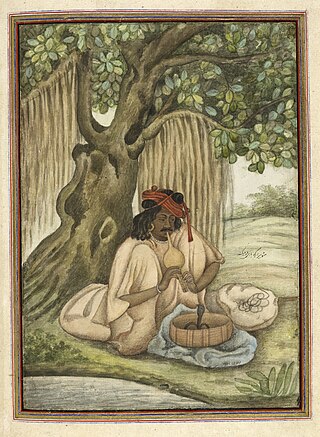Related Research Articles
The Bangali may refer to a Scheduled Caste found in northern India. They are distinct from the Bengali ethnic group of West Bengal and Bangladesh. The Bangali are one of the many nomadic groupings found in India, and have customs similar to other nomadic communities such as the Kanjar.
Saini is a caste of northern India. The community is given representation in government jobs and educational institutes as an Other Backward Class (OBC) in the states of Uttar Pradesh, Punjab, Haryana, Rajasthan and Madhya Pradesh.
Bazigar are an ethnic group of north-western India. They are primarily found in Punjab region of India and Pakistan, but there are also communities in Haryana, Uttar Pradesh, Delhi, Chandigarh, Himachal Pradesh, Jammu and Kashmir, and Rajasthan. They were previously nomadic with their main occupation the performance of acrobatics and other forms of entertainment, but they are now settled and engaged mainly in agricultural and forms of industrial services and businesses.

Nomads are known as a group of communities who travel from place to place for their livelihood. Some are salt traders, fortune-tellers, conjurers, ayurvedic healers, jugglers, acrobats, actors, storytellers, snake charmers, animal doctors, tattooists, grindstone makers, or basketmakers. Some anthropologists have identified about 8 nomadic groups in India, numbering perhaps 1 million people—around 0.12 percent of the country's billion-plus population. Aparna Rao and Michael Casimir estimated that nomads make up around 7% of the population of India.
Rajasthani people or Rajasthanis are a group of Indo-Aryan peoples native to Rajasthan, a state in Northern India. Their language, Rajasthani, is a part of the western group of Indo-Aryan languages.
Garha are a Muslim community in the subcontinent. They live pre-dominantly in the states of Punjab, Delhi, Uttar Pradesh, Haryana, Uttarakhand and Rajasthan.

The Sapera are a Hindu caste found in North India. They are also known as Barwa Sampheriya in West Bengal, Sapela in Punjab and Sparera in Madhya Pradesh.

The Nat are a Hindu caste found in northern India.
The Sikligar is a community found in the Indian states of Gujarat, Haryana, Rajasthan, and Punjab. By tradition, the Sikligar people specialized in the craft of making and polishing weapons. They are typically Hindu in Gujarat, Telangana, and Andhra Pradesh; Sikh in Punjab; and either Hindu and Sikh in Haryana.
The ' Rain, Raeen or Rayeen is a Muslim found in the state of Haryana, Punjab and Uttar Pradesh in India. They are also known as Chaudhary, Rao, Rai and Rana.
The Bharbhunja are an occupational caste found in North India and Maharashtra. They are also known as Kalenra in Maharashtra. A small number are also found in the Terai region of Nepal.
The Lakhera are a Hindu caste found in North India. They are a community traditionally associated with bangle making.
The Dabgar is a caste found in the states of Gujarat, Rajasthan, and Uttar Pradesh in India. They are also known as Dhalgar and have scheduled caste status in Rajasthan and Uttar Pradesh, while they have Other Backward Class status in Gujarat. In Rajasthan, the community prefer the self-designation as Dhalgar.
The Sirkiband are a Hindu caste found in the states of Haryana and Punjab in India. They have scheduled caste status in Haryana. A small number in Punjab are now Sikh.
The Singikat are a Hindu caste found in the state of Haryana, India. They are known as Gyarah.
The Deha, sometimes pronounced as Dahiya, Dhaya, Dhea, Daiya and Dheya are a caste found in India, and have other backward caste status in Haryana. They forms the largest jat community in Haryana.
The Gandhila sometimes pronounced as Gandhil and Gandola, are a Hindu caste found in North India. They have scheduled caste status in Punjab and Haryana.
The Kuchband are a Hindu caste found in the state of Haryana in India. They are also known as Gihara. The name Kuchband is derived from the Hindi word kuch, meaning a weavers brush, on account of their traditional occupation of manufacturing kuches. According to their traditions, the community emigrated from Rajasthan some three centuries ago. They are now found throughout Haryana, and speak Haryanvi. According to other traditions, the Kuchband are a sub-group of the Singikat community. Like other Hindu artisan castes, they no longer practice their traditional craft. Most Kuchband are now landless agricultural labourers.
The Heri are a Hindu caste found in the states of Haryana and Punjab in India.
The Rai Sikh is a Sikh community, mainly found in the states of Punjab, Rajasthan, Uttar Pradesh, Uttrakhand, Delhi and Haryana in India.
References
- ↑ People of Tiben: Lhasa (Volume XLII) edited by A Hasan & J C Das page 1500 to 150
- ↑ R.V. Russell (October 1995). The Tribes and Castes of the Central Provinces of India. Vol. IV. Published Under the Orders of the Central Provinces Administration, Macmillan and Co., Limited St. Martin's Street, London. 1916. p. 517. Retrieved 6 July 2011.
- ↑ People of India: Haryana (Volume XXIII) edited by M.L Sharma and A.K Bhatia pages 475 to 479 Manohar Books
- ↑ People of India: Uttar Pradesh (Volume XLII) edited by A Hasan & J C Das page 1500
- ↑ People of India: Haryana (Volume XXIII) edited by M.L Sharma and A.K Bhatia page 475 Manohar Books
- ↑ Population Monograph of Nepal, Volume II
- ↑ 2011 Nepal Census, District Level Detail Report
- ↑ https://translate.google.com/translate?u=https://indianexpress.com/article/political-pulse/how-and-why-congress-chose-raj-babbar-to-head-up-fight/&hl=hi&sl=en&tl=hi&client=srp&prev=search